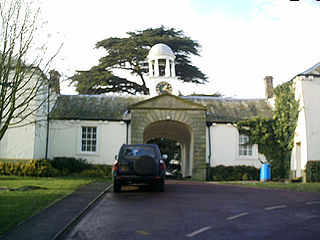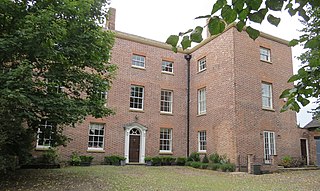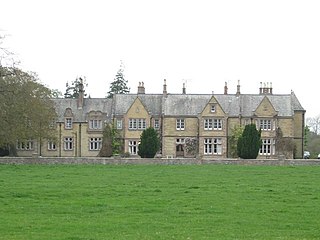
Edlingham Castle is a small castle ruin, having scheduled monument and Grade I listed building status, in the care of English Heritage. It is located in a valley to the west of Alnwick, Northumberland, England. It has been described as "...one of the most interesting in the county", by Nikolaus Pevsner, the architectural historian. Edlingham itself is little more than a hamlet with a church alongside the castle.

Shardeloes is a large 18th-century country house located one mile west of Amersham in Buckinghamshire, England, UK. A previous manor house on the site was demolished and the present building constructed between 1758 and 1766 for William Drake, Sr., the Member of Parliament for Amersham. Shardeloes is a Grade I listed building.
Baron Ogle is an abeyant title in the Peerage of England. It was created in 1461 for Robert Ogle. It fell into abeyance in 1691. The Ogles were a prominent Northumbrian family from before the time of the Norman Conquest. They settled at Ogle, Northumberland and in 1341 were granted a licence to fortify their manor house which became known as Ogle Castle. The family included seven Medieval Barons. Their estates fell by marriage to the Cavendish family following the death of the 7th Baron in 1597.

Hylton Castle is a stone castle in the North Hylton area of Sunderland, Tyne and Wear, England. Originally built from wood by the Hilton family shortly after the Norman Conquest in 1066, it was later rebuilt in stone in the late 14th to early 15th century. The castle underwent major changes to its interior and exterior in the 18th century and it remained the principal seat of the Hylton family until the death of the last Baron in 1746. It was then Gothicised but neglected until 1812, when it was revitalised by a new owner. Standing empty again until the 1840s, it was briefly used as a school until it was purchased again in 1862. The site passed to a local coal company in the early 20th century and was taken over by the state in 1950.
This is a list of the High Sheriffs of the English county of Northumberland. The High Sheriff is the oldest secular office under the Crown. Formerly the High Sheriff was the principal law enforcement officer in the county but over the centuries most of the responsibilities associated with the post have been transferred elsewhere or are now defunct, so that its functions are now largely ceremonial. The High Sheriff changes every March.

Wressle Castle is a ruined palace-fortress in the East Riding of Yorkshire, England, built for Thomas Percy in the 1390s. It is privately owned and not open to the public. Wressle Castle originally consisted of four ranges built around a central courtyard; there was a tower at each corner, and the structure was entered through a gatehouse in the east wall, facing the village.

Ogle is a village in and former civil parish, now in the parish of Whalton, Northumberland, England, north-west of Ponteland and south-west of Morpeth. The surname Ogle comes from here, where the Ogle family built Ogle Castle and owned Kirkley Hall. In 1951 the parish had a population of 122.

Eglingham is a village in Northumberland, England, situated about 7 miles (11 km) north-west of Alnwick and 10 miles (16 km) from Wooler. It lies in the sheltered valley of the Eglingham Burn, a tributary of the River Aln, about 100 metres (330 ft) above sea level, in a rural conservation area set amongst rolling countryside, within 5 miles (8 km) of the Cheviot Hills. The village is surrounded by mainly arable farmland, moorland and woodland, including an arboretum and some commercial forestry.

Kirkley Hall is a 17th-century historic country mansion and Grade II listed building in Northumberland, England. The estate is over 190 acres (0.77 km2) and adjoins the River Blyth at Kirkley, three miles north of Ponteland in the heart of the Northumberland countryside, which is now a Horticultural and Agricultural training centre.

Belford Hall is a Grade I listed building, an 18th-century mansion house situated at Belford, Northumberland.
Northumberland, was a County constituency of the House of Commons of the Parliament of England then of the Parliament of Great Britain from 1707 to 1800 and of the Parliament of the United Kingdom from 1801 to 1832. It was represented by two Members of Parliament.

Lilburn Tower is a privately owned 19th-century mansion house at Lilburn, near Wooler, Northumberland. The property is a Grade II* listed building and forms part of the Lilburn Estate. A number of discrete buildings and monuments are scattered across the grange, including the Hurlestone, Hurlestone Tower and an astronomical observatory.

The Belair Mansion, located in the historic Collington area and in Bowie, Maryland, United States, built in c. 1745, is the Georgian style plantation house of Provincial Governor of Maryland, Samuel Ogle. Later home to another Maryland governor, the mansion is listed on the National Register of Historic Places.
The Ogle family were prominent landed gentry in Northumberland, England. The earliest appearances of the family name were written Hoggel, Oggehill, Ogille and Oghill.

Adderstone Hall is a privately owned Georgian Grecian mansion situated on the bank of the River Warn near Lucker, Northumberland. It is a Grade II* listed building from which the present owners operate a holiday park.

Churche's Mansion is a timber-framed, black-and-white Elizabethan mansion house at the eastern end of Hospital Street in Nantwich, Cheshire, England. The Grade I listed building dates from 1577, and is one of the very few to have survived the Great Fire of Nantwich in 1583.

Rocksavage or Rock Savage was an Elizabethan mansion, which served as the primary seat of the Savage family. The house now lies in ruins, at SJ526799 in Clifton, Cheshire, England. Built for Sir John Savage, MP in 1565–1568, Rocksavage was one of the great Elizabethan houses of the county, a leading example of the Elizabethan prodigy house; in 1674, it was the second largest house in Cheshire. James I visited in 1617. The house was abandoned when it passed into the Cholmondeley family early in the 18th century, and by 1782 only ruins remained.

The Porch House, formerly sometimes the Porche House, is a large Georgian house, dating from the late 18th century, in Nantwich, Cheshire, England. It is listed at grade II. Located at numbers 64A and 64B on the north side of Welsh Row, it is entered via its former stable entrance, The Gateway. Currently divided into two houses, the Porch House has previously served as a day and boarding school, and as a house for Belgian refugees. The existing building stands on the site of a 15th-century mansion of the same name.

Sir Charles Cavendish was an English landowner.

Carham Hall is a grade II listed building near Carham in Northumberland, England. The site, on the Scottish border, was previously occupied by a medieval tower house, built as a defence from border reivers. The Compton family purchased the estate in 1754 and the following year erected the first Carham Hall, a relatively plain building in the Classical style. The hall passed to the Hodgson family and in 1870 Richard Hodgson-Huntley ordered it be rebuilt on a grander scale, in four bays. The hall and estate were afterwards owned by the Perkins family, a daughter of which, Nancy, married William Matthew Burrell in 1903. Nancy Burrell commissioned Scottish architect James Bow Dunn to extend the hall in 1920. This extension added a further four bays to the western end of the structure, creating a larger, linear building. The house was later owned by Sir Thomas Straker-Smith.
















